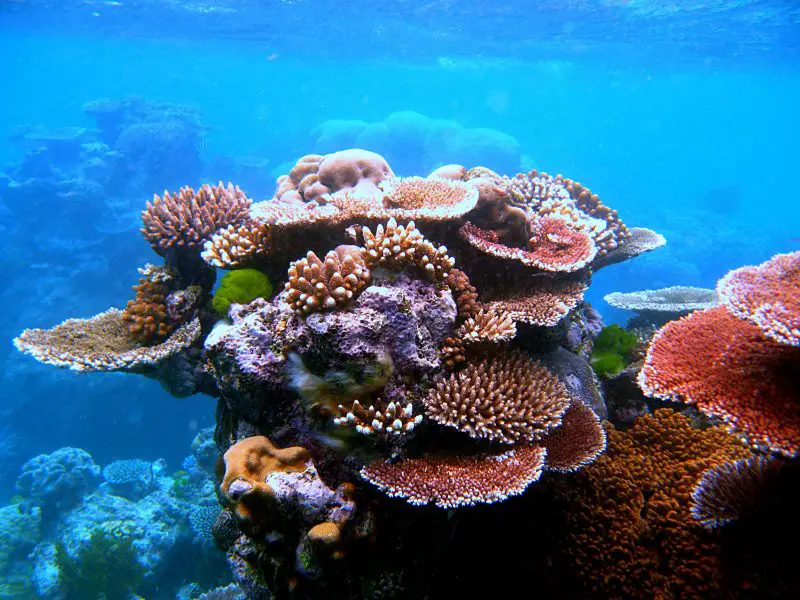Corals are among the most fascinating life forms on Earth. Though they may appear to be simple, colorful rocks decorating the seafloor, corals are living animals with complex survival strategies. Found mainly in warm, shallow tropical waters, corals have thrived for millions of years. But how do these seemingly delicate creatures survive in the vast and sometimes harsh environment of the ocean? Their survival hinges on remarkable biological partnerships, structural ingenuity, and precise environmental adaptation.

What Are Corals?
Corals are marine invertebrates that belong to the phylum Cnidaria, which also includes jellyfish and sea anemones. Each coral is made up of thousands of tiny polyps—soft-bodied organisms with a central mouth surrounded by tentacles. These polyps live in colonies and secrete calcium carbonate to form a hard skeleton. Over time, this skeleton becomes the foundation of coral reefs, some of the largest biological structures on Earth.
The Coral-Algae Symbiosis
Zooxanthellae: The Invisible Engines of Coral Life
Beneath the clear blue waters of tropical oceans, where sunlight dances across coral gardens, a hidden alliance is quietly powering one of the most vibrant ecosystems on Earth. At the heart of this symbiosis is a partnership so profound, it blurs the lines between plant and animal, individual and community. Coral polyps—tiny, tentacled animals no larger than a grain of rice—harbor within their tissues millions of microscopic algae known as zooxanthellae. Though invisible to the naked eye, these algae are the true engines of coral life.
By harnessing sunlight through photosynthesis, zooxanthellae convert solar energy into simple sugars. These sugars are not kept for themselves. Instead, up to 90% of the energy produced is transferred directly to the coral host, fueling its metabolism, growth, and the construction of massive reef structures made of calcium carbonate. In essence, corals become solar-powered animals, thriving in clear, nutrient-poor waters where most other life struggles to survive.
But this isn’t a one-way street. In return for their energy contributions, the zooxanthellae enjoy a safe haven inside coral tissue—a moist, sunlit space rich in carbon dioxide and nitrogenous waste that the algae use as fertilizer. It’s a perfect trade: coral gets food, algae get shelter and nutrients. This mutualistic relationship is so tightly woven that the coral and algae begin to function almost like a single organism.
When the Partnership Breaks: Coral Bleaching as a System Failure
Yet this delicate bond is highly sensitive to disruption. A slight increase in ocean temperature, a rise in acidity, or pollutants entering the reef can trigger the coral to expel its algal tenants, disrupting this ancient partnership. Without zooxanthellae, the coral loses its primary energy source and its color—hence the stark white appearance of bleached coral. This isn’t just a cosmetic change; it’s a sign of a system in crisis. If new algae don’t return soon, the coral will starve, weaken, and eventually die.
Bleaching events are akin to forest fires in the sea—rapid, devastating, and often triggered by climate change. And because coral reefs support an estimated 25% of all marine life, the collapse of this symbiotic relationship can send ripples through the entire ocean food web.
A Second Source of Life: Coral as a Hunter
Though corals rely heavily on sunlight and algae, they aren’t entirely passive. When the sun dips below the horizon, coral polyps emerge like nocturnal predators, stretching their delicate tentacles into the current. Each tentacle is armed with cnidocytes—specialized stinging cells that fire microscopic harpoons loaded with venom to capture tiny plankton and organic particles drifting by.
Once immobilized, the prey is drawn into the polyp’s central mouth and digested in its gastrovascular cavity. This supplemental feeding provides proteins, lipids, and minerals that algae alone cannot supply, especially crucial when light levels are low or during bleaching recovery. This dual feeding strategy—photosynthesis by day, carnivory by night—makes corals both autotrophic and heterotrophic, a rare and resourceful adaptation in the animal kingdom.
A Symbiosis of Survival and Innovation
What makes this coral-algae partnership extraordinary is not just its efficiency, but its elegant interdependence. It is a relationship that has evolved over hundreds of millions of years, fine-tuned by time and natural selection to thrive in one of the most competitive environments on Earth. Coral reefs are built not by brute force, but by microscopic cooperation, a quiet alliance that powers entire marine nations.
In the face of a warming planet, understanding and protecting this symbiosis may be one of our best hopes for preserving the rich biodiversity of the oceans. It is more than a scientific curiosity—it is a symbol of balance, adaptation, and the incredible power of life working together.
Building Strong Foundations: Coral Skeletons
Corals build their own homes by extracting calcium and carbonate ions from seawater and depositing them as calcium carbonate (CaCO₃). This process creates a rigid skeleton that not only protects individual polyps but also supports the growth of entire coral colonies. Over generations, these structures accumulate and form massive reef systems.
These skeletons are durable and help corals anchor to stable surfaces such as rocks or submerged objects. As long as environmental conditions remain favorable, coral reefs can grow for thousands of years, creating ecosystems that support a vast diversity of marine life.
Environmental Conditions for Coral Survival
Light, Temperature, and Water Quality: A Delicate Balance
To the casual eye, coral reefs may seem as carefree as the fish that flit between them. But behind their vibrant beauty lies a world of precision and constraint. Corals are not hardy generalists; they are environmental specialists, thriving only within the narrowest of comfort zones. Their lives revolve around one essential force—light.
Sunlight fuels the tiny algae inside coral tissues, and without it, the entire reef system would grind to a halt. That’s why most reef-building corals are found in crystal-clear, shallow waters, where sunlight can reach every corner. Descend beyond 60 meters, and the light fades, photosynthesis stalls, and coral life begins to vanish.
Temperature, too, must fall within a narrow window. Warm tropical seas between 23°C and 29°C (73°F to 84°F) provide the ideal climate for coral growth. But corals live close to their thermal limit. Just a slight rise—like during a marine heatwave—can send them spiraling into bleaching, as they eject their life-giving algae in a desperate attempt to survive. Cool the water too much, and their metabolic processes slow, weakening the colony’s ability to build, feed, and defend itself.
And then there’s the invisible threat: the quality of the water itself. Coral reefs thrive not in rich, nutrient-laden waters, but in nutrient-poor (oligotrophic) zones where competition from fast-growing algae is low. Paradoxically, too many nutrients—often from agricultural runoff or sewage—can choke the reef. Excess nutrients trigger algal blooms that smother coral, block sunlight, and rob the ecosystem of balance. For corals, purity means survival. Clear, moving water brings oxygen, sweeps away waste, and delivers the chemical calm in which reefs flourish.
Solid Ground and Gentle Currents: The Foundation of a Reef
A coral can only grow where it can hold on. These tiny polyps need solid, stable surfaces to settle and build upon—be it rock, submerged skeleton, or reef platform. But sediment, the fine silt stirred up by coastal erosion or flowing rivers, can cloud the water like dust in the air. If it settles on young coral, it can smother them before they ever have a chance to grow.
Even in established reefs, sediment poses a threat. It blocks sunlight, dulling the power of photosynthesis, and can cause physical damage to the delicate coral structure. That’s why coral reefs rarely bloom near river mouths or muddy coastlines. Instead, they thrive where wave action and currents keep sediments suspended and away—a subtle dance between movement and stillness that allows life to anchor itself in motion.
Coral Reproduction and Regeneration
Sexual Reproduction: Synchronized Spawning and Ocean Drifters
Beneath the surface of the sea, under the soft glow of a full moon, one of nature’s most spectacular events quietly unfolds. In a display of perfect synchronicity, millions of coral colonies across vast reefs release clouds of eggs and sperm into the water column, turning the ocean into a living constellation. This mass spawning is not random—it’s finely tuned to the lunar calendar, temperature, and even the tides, ensuring that reproductive success is maximized across the reef.
Fertilization happens not within the coral, but in the open sea. Once sperm and eggs meet, they form free-floating larvae called planulae, which drift with ocean currents for days or weeks. These tiny wanderers are vulnerable, yet full of potential. When a planula finally finds a suitable, stable surface—like a bare rock or piece of reef—it settles, transforms into a polyp, and begins to build a new coral colony from scratch.
This method of reproduction isn’t just about numbers—it’s about diversity. Each fertilized egg carries a unique combination of genes, which strengthens the coral population’s ability to adapt to new diseases, rising temperatures, or shifting environments. It’s nature’s way of ensuring that coral reefs don’t just survive, but evolve.
Asexual Reproduction: The Coral’s Power to Clone and Heal
But corals don’t rely solely on lunar rhythms and drifting larvae. They also reproduce asexually, and this method is just as critical to their survival. Through a process called budding, a coral polyp can divide and produce a genetically identical copy of itself. These clones remain attached, forming the dense, intricate colonies that characterize healthy reefs.
Even more remarkable is the coral’s ability to regrow from fragments. When storms, boat anchors, or human activity break off pieces of coral, those fragments aren’t necessarily lost. If the broken piece lands on a stable surface in the right conditions, it can reattach, heal, and start a new colony—like a severed branch sprouting into a new tree.
This regenerative superpower plays a vital role in reef recovery after damage. It gives corals a second chance, allowing them to bounce back from physical trauma without starting from scratch. In many reef restoration projects, scientists use this very trait—planting coral fragments like underwater gardeners—to rebuild damaged reefs and speed up natural recovery.
Defense Mechanisms and Coral Competition
Though stationary, corals are not defenseless. Some corals develop aggressive strategies to compete for space and light. They may extend specialized tentacles called sweeper tentacles to sting neighboring colonies or secrete chemicals that inhibit the growth of competitors. Certain coral species form alliances with crabs or shrimp that help defend the coral from predators like starfish.
These biological strategies help corals maintain their territory in a densely packed and competitive underwater environment.
Threats to Coral Survival
Despite their resilience, corals are facing unprecedented threats. Climate change, rising ocean temperatures, ocean acidification, overfishing, and coastal pollution are putting immense pressure on coral ecosystems. Bleaching events have become more frequent, and the growing acidity of seawater reduces the availability of carbonate ions needed to build skeletons.
Human activities such as irresponsible tourism, destructive fishing practices, and coastal development also degrade coral habitats. While corals have adapted to survive in the ocean for millions of years, these modern challenges may exceed their natural coping abilities.
Conclusion
Corals survive in the ocean through a delicate balance of biological partnerships, structural innovations, and environmental precision. Their symbiosis with zooxanthellae provides energy, their calcium carbonate skeletons offer protection and habitat, and their diverse reproductive strategies ensure persistence across generations. However, these ancient survivors are now facing challenges that threaten their very existence. Protecting coral reefs is not just about saving beautiful underwater landscapes—it’s about preserving one of Earth’s most vital ecosystems that supports marine biodiversity, coastal protection, and human livelihoods.






